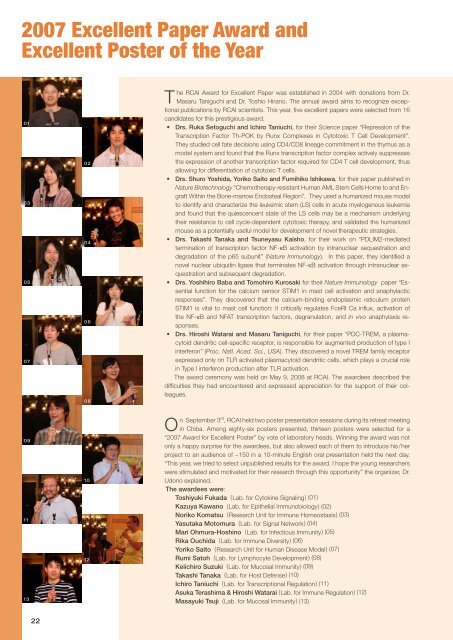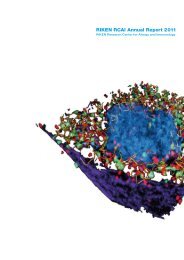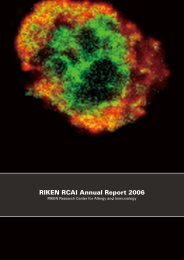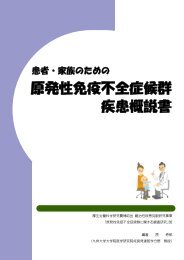in vivo
in vivo
in vivo
You also want an ePaper? Increase the reach of your titles
YUMPU automatically turns print PDFs into web optimized ePapers that Google loves.
2007 Excellent Paper Award and<br />
Excellent Poster of the Year<br />
01<br />
03<br />
05<br />
07<br />
09<br />
11<br />
13<br />
02<br />
04<br />
06<br />
08<br />
10<br />
12<br />
The RCAI Award for Excellent Paper was established <strong>in</strong> 2004 with donations from Dr.<br />
Masaru Taniguchi and Dr. Toshio Hirano. The annual award aims to recognize exceptional<br />
publications by RCAI scientists. This year, five excellent papers were selected from 16<br />
candidates for this prestigious award.<br />
• Drs. Ruka Setoguchi and Ichiro Taniuchi, for their Science paper “Repression of the<br />
Transcription Factor Th-POK by Runx Complexes <strong>in</strong> Cytotoxic T Cell Development”.<br />
They studied cell fate decisions us<strong>in</strong>g CD4/CD8 l<strong>in</strong>eage commitment <strong>in</strong> the thymus as a<br />
model system and found that the Runx transcription factor complex actively suppresses<br />
the expression of another transcription factor required for CD4 T cell development, thus<br />
allow<strong>in</strong>g for differentiation of cytotoxic T cells.<br />
• Drs. Shuro Yoshida, Yoriko Saito and Fumihiko Ishikawa, for their paper published <strong>in</strong><br />
Nature Biotechnology “Chemotherapy-resistant Human AML Stem Cells Home to and Engraft<br />
With<strong>in</strong> the Bone-marrow Endosteal Region”. They used a humanized mouse model<br />
to identify and characterize the leukemic stem (LS) cells <strong>in</strong> acute myelogenous leukemia<br />
and found that the quiescencent state of the LS cells may be a mechanism underly<strong>in</strong>g<br />
their resistance to cell cycle-dependent cytotoxic therapy, and validated the humanized<br />
mouse as a potentially useful model for development of novel therapeutic strategies.<br />
• Drs. Takashi Tanaka and Tsuneyasu Kaisho, for their work on “PDLIM2-mediated<br />
term<strong>in</strong>ation of transcription factor NF-κB activation by <strong>in</strong>tranuclear sequestration and<br />
degradation of the p65 subunit” (Nature Immunology). In this paper, they identified a<br />
novel nuclear ubiquit<strong>in</strong> ligase that term<strong>in</strong>ates NF-κB activation through <strong>in</strong>tranuclear sequestration<br />
and subsequent degradation.<br />
• Drs. Yoshihiro Baba and Tomohiro Kurosaki for their Nature Immunology paper “Essential<br />
function for the calcium sensor STIM1 <strong>in</strong> mast cell activation and anaphylactic<br />
responses”. They discovered that the calcium-b<strong>in</strong>d<strong>in</strong>g endoplasmic reticulum prote<strong>in</strong><br />
STIM1 is vital to mast cell function: it critically regulates FceRI Ca <strong>in</strong>flux, activation of<br />
the NF-κB and NFAT transcription factors, degranulation, and <strong>in</strong> <strong>vivo</strong> anaphylaxis responses.<br />
• Drs. Hiroshi Watarai and Masaru Taniguchi, for their paper “PDC-TREM, a plasmacytoid<br />
dendritic cell-specific receptor, is responsible for augmented production of type I<br />
<strong>in</strong>terferon” (Proc. Natl. Acad. Sci., USA). They discovered a novel TREM family receptor<br />
expressed only on TLR activated plasmacytoid dendritic cells, which plays a crucial role<br />
<strong>in</strong> Type I <strong>in</strong>terferon production after TLR activation.<br />
The award ceremony was held on May 9, 2008 at RCAI. The awardees described the<br />
difficulties they had encountered and expressed appreciation for the support of their colleagues.<br />
On September 3 rd , RCAI held two poster presentation sessions dur<strong>in</strong>g its retreat meet<strong>in</strong>g<br />
<strong>in</strong> Chiba. Among eighty-six posters presented, thirteen posters were selected for a<br />
“2007 Award for Excellent Poster” by vote of laboratory heads. W<strong>in</strong>n<strong>in</strong>g the award was not<br />
only a happy surprise for the awardees, but also allowed each of them to <strong>in</strong>troduce his/her<br />
project to an audience of ~150 <strong>in</strong> a 10-m<strong>in</strong>ute English oral presentation held the next day.<br />
“This year, we tried to select unpublished results for the award. I hope the young researchers<br />
were stimulated and motivated for their research through this opportunity” the organizer, Dr.<br />
Udono expla<strong>in</strong>ed.<br />
The awardees were:<br />
Toshiyuki Fukada (Lab. for Cytok<strong>in</strong>e Signal<strong>in</strong>g) (01)<br />
Kazuya Kawano (Lab. for Epithelial Immunobiology) (02)<br />
Noriko Komatsu (Research Unit for Immune Homeostasis) (03)<br />
Yasutaka Motomura (Lab. for Signal Network) (04)<br />
Mari Ohmura-Hosh<strong>in</strong>o (Lab. for Infectious Immunity) (05)<br />
Rika Ouchida (Lab. for Immune Diversity) (06)<br />
Yoriko Saito (Research Unit for Human Disease Model) (07)<br />
Rumi Satoh (Lab. for Lymphocyte Development) (08)<br />
Keiichiro Suzuki (Lab. for Mucosal Immunity) (09)<br />
Takashi Tanaka (Lab. for Host Defense) (10)<br />
Ichiro Taniuchi (Lab. for Transcriptional Regulation) (11)<br />
Asuka Terashima & Hiroshi Watarai (Lab. for Immune Regulation) (12)<br />
Masayuki Tsuji (Lab. for Mucosal Immunity) (13)<br />
22





